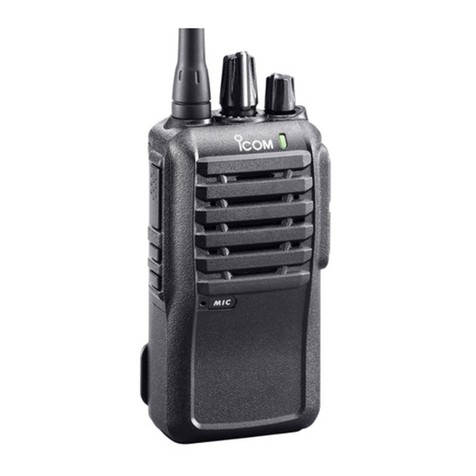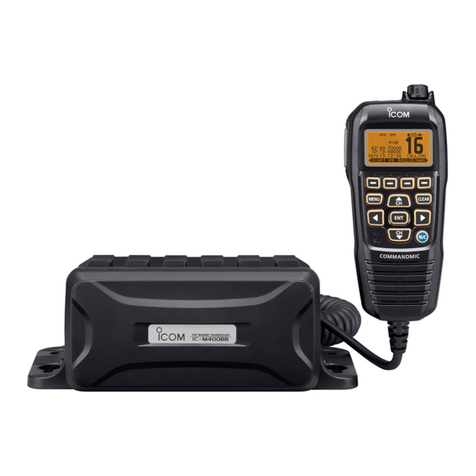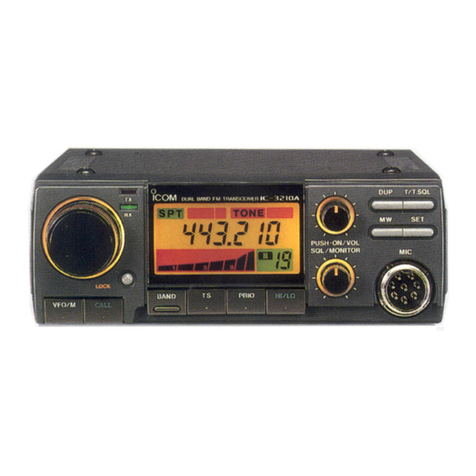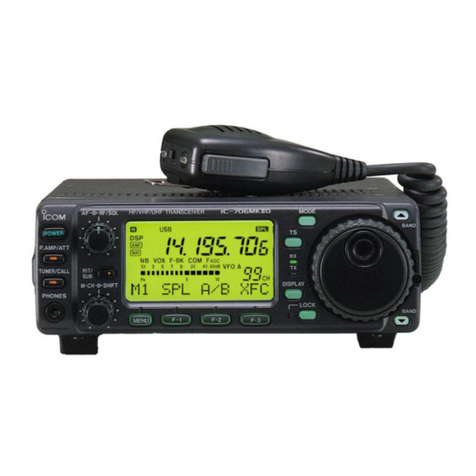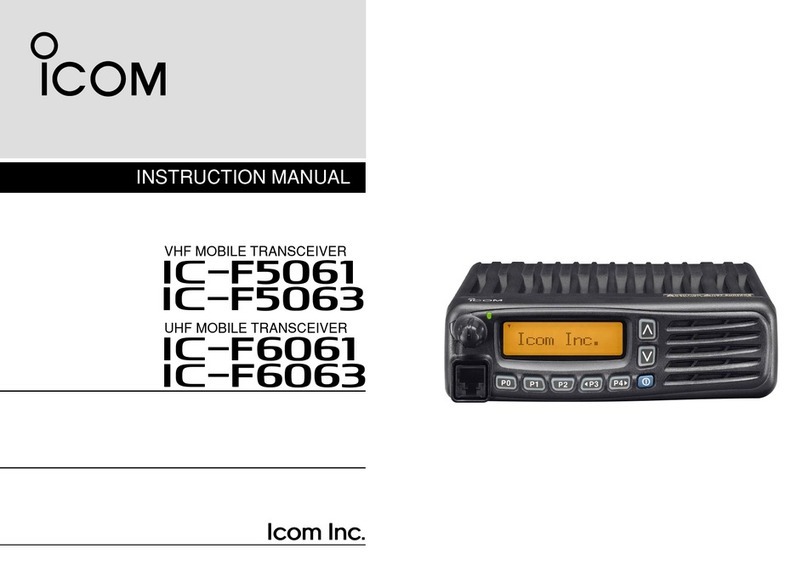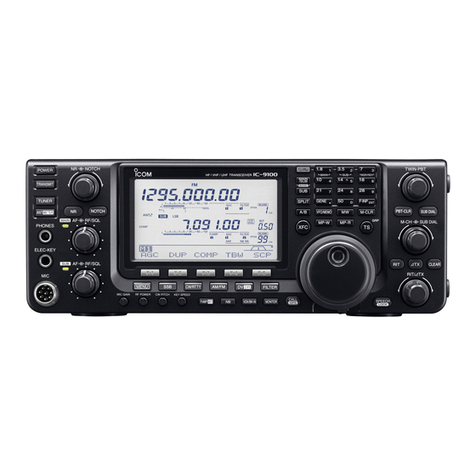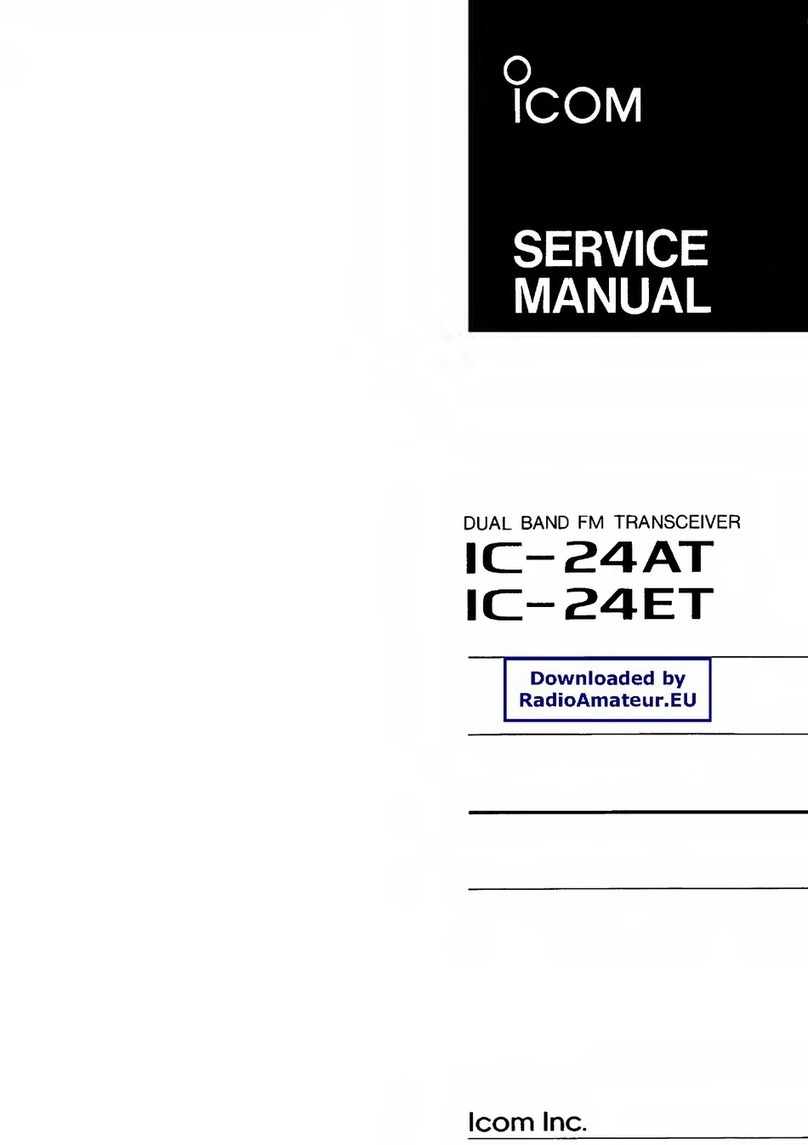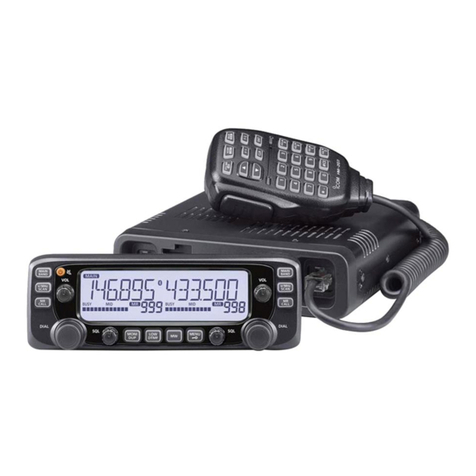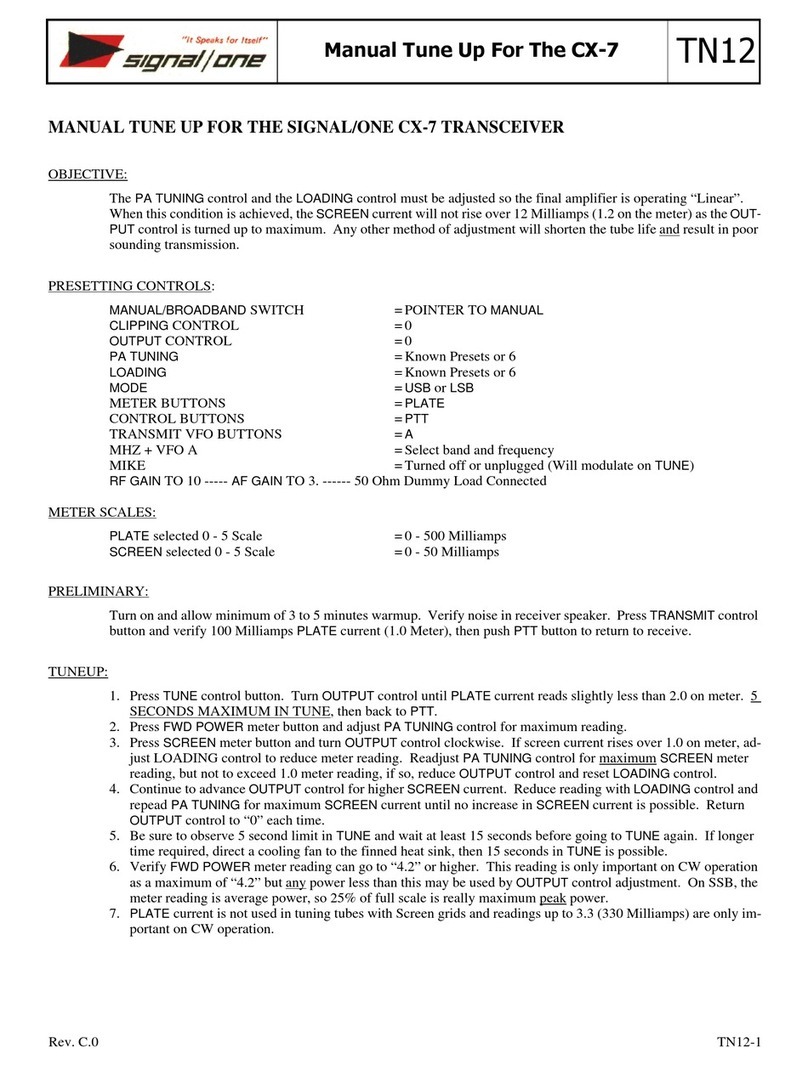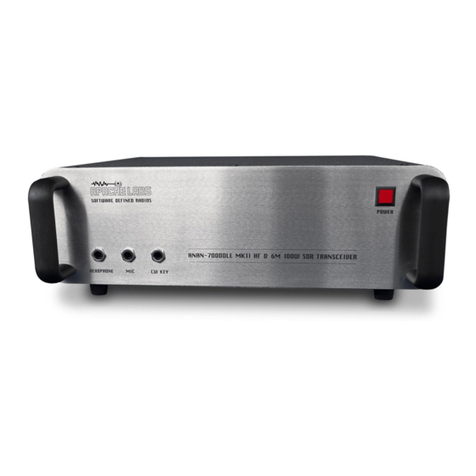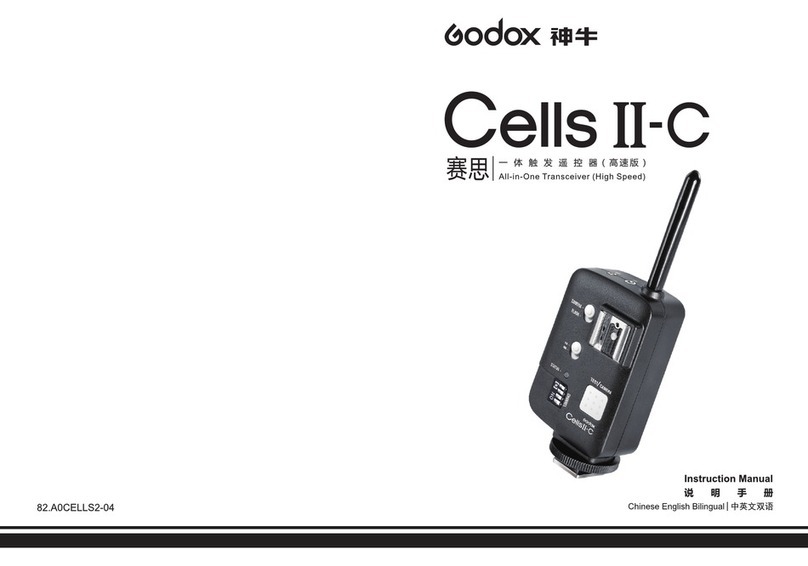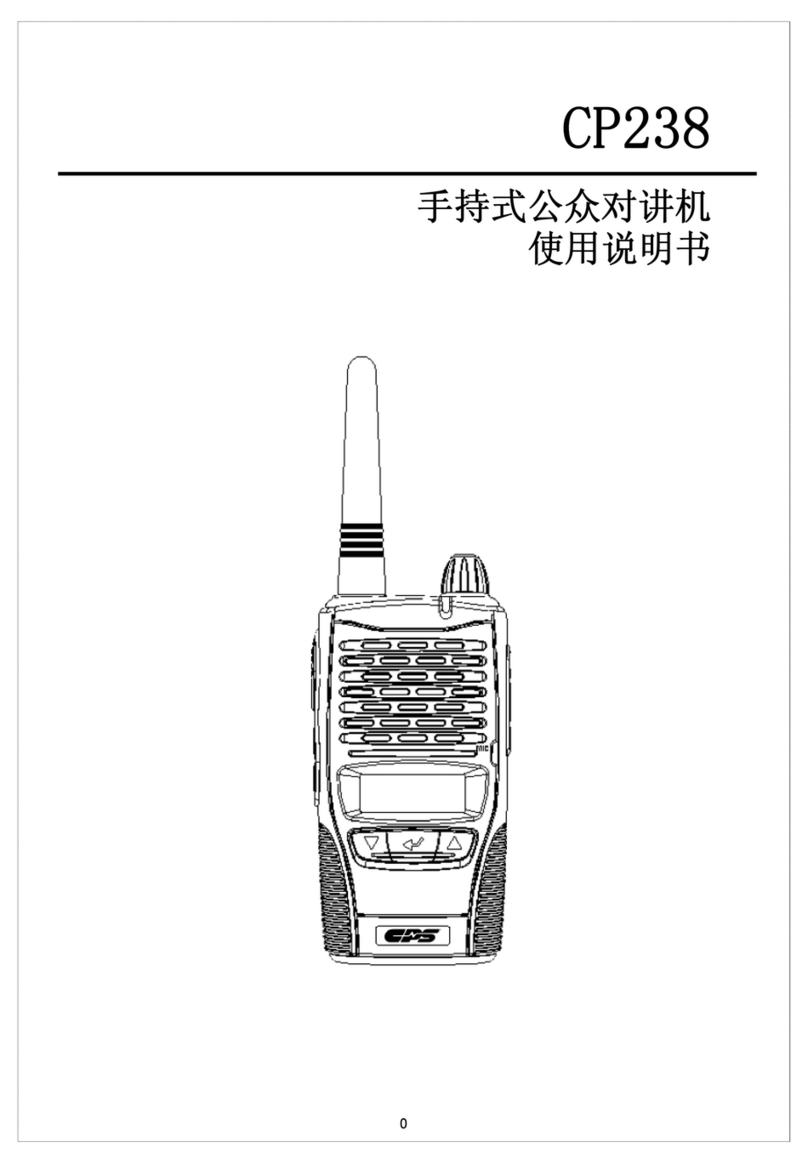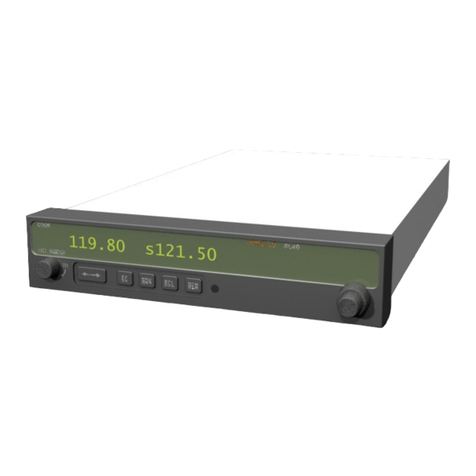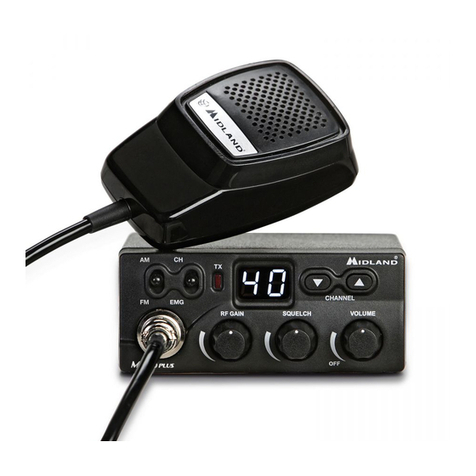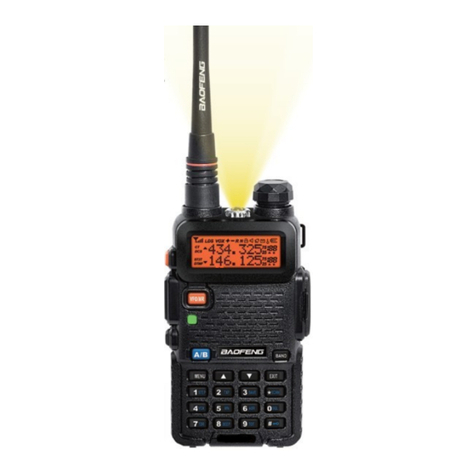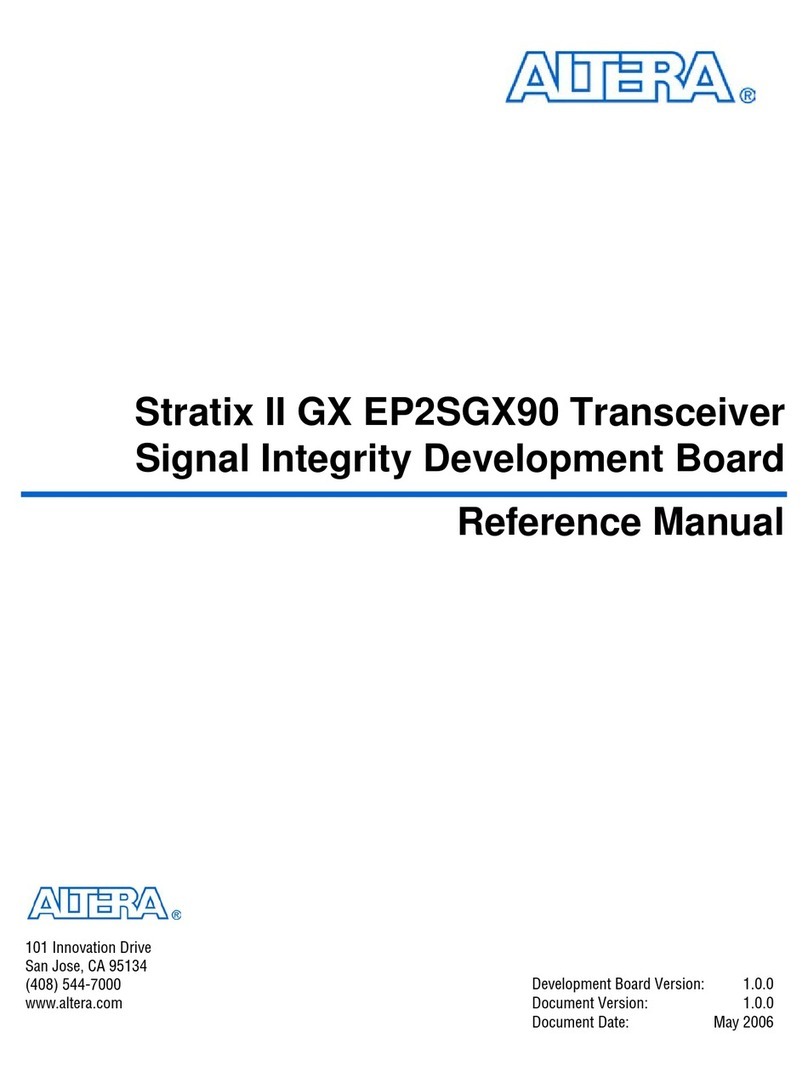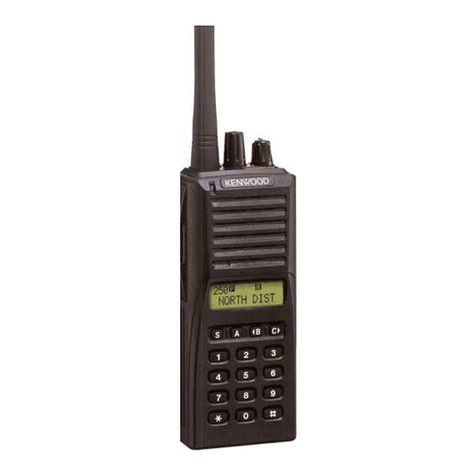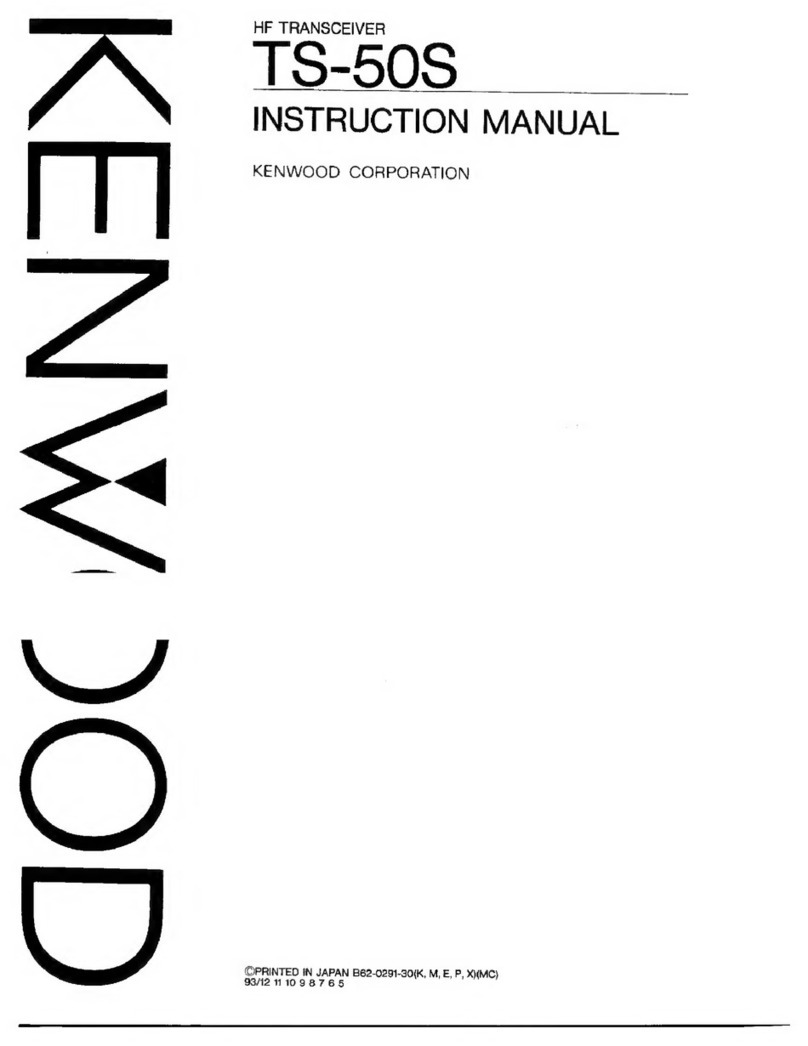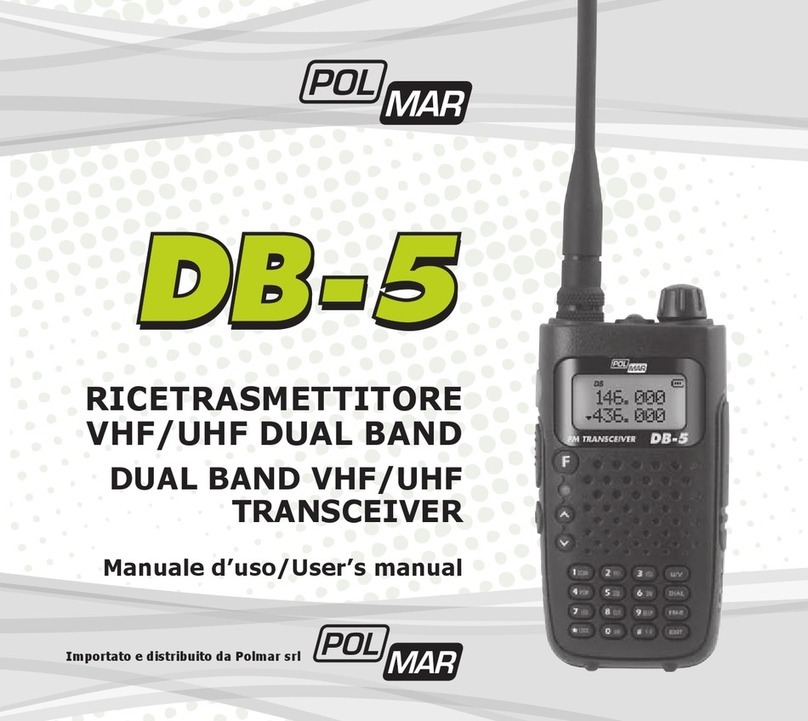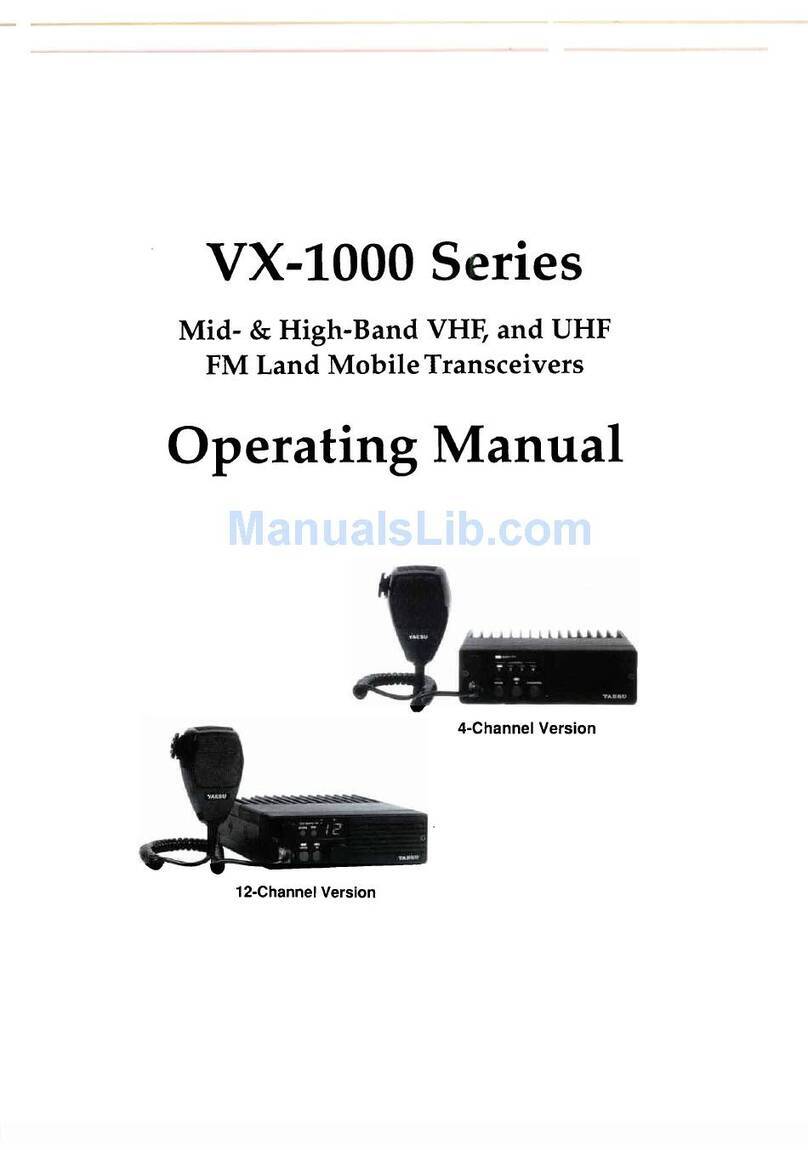Icom IC-M94D User manual

INSTRUCTION MANUAL
VHF MARINE TRANSCEIVER
|M94D
This device complies with Part 15 of the FCC
Rules. Operation is subject to the condition that
this device does not cause harmful interference.

i
■Important
READ ALL INSTRUCTIONS carefully and
completely before using the transceiver.
SAVE THIS INSTRUCTION MANUAL—
This instruction manual contains important
operating instructions for the IC-M94D.
This instruction manual includes some
functions that are usable only when they
are preset by your dealer. Ask your dealer
for details.
■Features
zIntuitive user interface
z6 W RF output, 1.5 W loud audio
zBasic AIS (Automatic Identication
System) receiver functions
Thank you for choosing this Icom product. This product was designed and built with
Icom’s state of the art technology and craftsmanship. With proper care, this product
should provide you with years of trouble-free operation.
Icom is not responsible for the
destruction, damage to, or performance
of any Icom or non-Icom equipment, if the
malfunction is because of:
• Force majeure, including, but not
limited to, res, earthquakes, storms,
oods, lightning, other natural disasters,
disturbances, riots, war, or radioactive
contamination.
• The use of Icom transceivers with any
equipment that is not manufactured or
approved by Icom.
Icom, Icom Inc. and the Icom logo are
registered trademarks of Icom Incorporated
(Japan) in Japan, the United States, the
United Kingdom, Germany, France, Spain,
Russia, Australia, New Zealand, and/or
other countries.
AquaQuake is a trademark of Icom
Incorporated.
All other products or brands are registered
trademarks or trademarks of their
respective holders.
■Explicit denitions
WORD DEFINITION
RDANGER! Personal death, serious
injury or an explosion may
occur.
RWARNING! Personal injury, re hazard
or electric shock may
occur.
CAUTION Equipment damage may
occur.
NOTE
If disregarded,
inconvenience only. No risk
of personal injury, re or
electric shock.
■Dénitions explicites
TERME DÉFINITION
RDANGER !
Risque d’accident
mortel, de blessures
corporelles graves ou
d’explosion.
RAVERTISSEMENT!
Risque de blessures
corporelles, d’incendie
ou de choc électrique.
MISE EN GARDE Risque de dégât
matériel.
REMARQUE
Inconvénient
seulement, en cas de
nonrespect. Absence
de risque de blessures
corporelles, d’incendie
ou de choc électrique.

ii
1
7
4
10
15
18
2
8
13
5
11
16
3
9
14
6
12
17
■Recommendation
CLEAN THE TRANSCEIVER THOROUGHLY IN A BOWL OF FRESH WATER after
exposure to saltwater, and dry it before operating. Otherwise, the transceiver’s keys and
switches may become unusable, due to salt crystallization.
NOTE: If the transceiver’s waterproof protection appears defective, carefully clean
it with a soft, damp (fresh water) cloth, then dry it before operating. The transceiver
may lose its waterproof protection if the case, jack cover, or battery cover is cracked
or broken, or the transceiver has been dropped. Contact your Icom distributor or your
dealer for advice.
■In case of emergency
If your vessel requires assistance, contact other vessels and the Coast Guard by sending
a distress call on Channel 16, or, transmit your Distress call using Digital Selective Calling
(DSC) on Channel 70.
DUSING CHANNEL 16
1. Push [16/C] to switch to Channel 16.
2. While holding down [PTT], give the appropriate information as follows:
z“MAYDAY MAYDAY MAYDAY.”
z“THIS IS ” (name of vessel).
zSay your call sign or other indication of the vessel
(AND your 9 digit DSC ID, if you have one).
z“LOCATED AT ” (your position).
zState the nature of the distress and assistance required.
zGive any other information which might facilitate the rescue.
DUSING DIGITAL SELECTIVE CALLING
1. Lift up the key cover, hold down [DISTRESS] for 3 seconds until the 3 short beeps
and then one long beep sound.
Key cover
2. Wait for an acknowledgment from another station.
3. After the acknowledgement is received, Channel 16 is automatically selected.
4. Hold down [PTT], then transmit the appropriate information as listed above.

iii
■Precautions
RDANGER! NEVER operate the
transceiver near unshielded electrical
blasting caps or in an explosive
atmosphere. This could cause an explosion
and death.
RWARNING! NEVER use or charge Icom
battery packs with non-Icom transceivers
or non-Icom chargers. Only Icom battery
packs are tested and approved for use with
Icom transceivers or charged with Icom
chargers. Using third-party or counterfeit
battery packs or chargers may cause
smoke, re, or cause the battery to burst.
RWARNING! NEVER hold the
transceiver so that the antenna is very
close to, or touching exposed parts of the
body, especially the face or eyes, while
transmitting.
RWARNING! NEVER operate the
transceiver with a headset or other
audio accessories at high volume levels.
The continuous high volume operation
may cause a ringing in your ears. If you
experience the ringing, reduce the volume
level or discontinue use.
CAUTION: DO NOT short the terminals of
the battery pack. Shorting may occur if the
terminals touch metal objects such as a
key, so be careful when placing the battery
packs (or the transceiver) in bags, and so
on. Carry them so that shorting cannot
occur with metal objects. Shorting may
damage not only the battery pack, but also
the transceiver.
CAUTION: DO NOT use harsh solvents
such as Benzine or alcohol when cleaning.
This could damage the equipment
surfaces. If the surface becomes dusty or
dirty, wipe it clean with a soft, dry cloth.
CAUTION: DO NOT place or leave
the transceiver in excessively dusty
environments. This could damage the
transceiver.
NOTE: DO NOT place or leave the
transceiver in direct sunlight or in areas
outside of the specied temperature range:
–20°C (–4˚F) ~ +60°C (+140˚F)
Keep the transceiver in a secure place to
prevent use by unauthorized persons.
BE CAREFUL! The transceiver meets
IPX7 requirements for waterproof
protection. However, once the transceiver
has been dropped, waterproof protection
cannot be guaranteed due to the fact that
the transceiver may be cracked, or the
waterproof seal damaged, and so on.
* Only when the supplied battery cover and
jack cover are attached.
Information:
In this instruction manual, the transceiver
version names are described as shown below.
U.S.A.: USA Export: EXP

iv
1
7
4
10
15
18
2
8
13
5
11
16
3
9
14
6
12
17
■Précautions
MISE EN GARDE : NE PAS utiliser
de dissolvants agressifs tels que du
Benzène ou de l’alcool lors du nettoyage,
car ils endommageraient les surfaces
de l’émetteur-récepteur. Si l’émetteur-
récepteur est poussiéreux ou sale,
nettoyez-le avec un tissu doux et sec.
MISE EN GARDE : NE PAS placer
l’émetteur-récepteur dans des
environnements excessivement
poussiéreux. Cela pourrait endommager
l’émetteur-récepteur.
REMARQUE : NE PAS placer ou laisser
l’émetteur-récepteur en plein soleil ou
dans un environnement soumis à des
températures inférieures à –20°C (–4˚F) ou
supérieures à +60°C (+140˚F).
Placez l’émetteur-récepteur dans un lien
sûr pour éviter toute utilisation par des
personnes non autorisées.
MISE EN GARDE : Cet émetteur-récepteur
répond aux exigences de la norme IPX7 en
matière de protection étanche. Cependant,
en cas de chute de l’émetteur-récepteur,
la protection étanche ne peuvent plus être
garanties, car le boitier risque d’être ssuré
ou le joint d’étanchéité endommagé, etc.
* Uniquement lorsque le couvercle de la
batterie et le cache-prise sont xés.
RDANGER ! NE JAMAIS utiliser
l’émetteur-récepteur à proximité de
détonateurs électriques non blindés ou
dans une atmosphère explosive. Cela
pourrait causer une explosion mortelle.
RAVERTISSEMENT ! N’utilisez JAMAIS
et ne rechargez JAMAIS des blocsbatteries
Icom avec des émetteurs-récepteurs
non-Icom ou des chargeurs non-Icom.
Seuls les blocsbatteries Icom sont testés
et homologués pour être utilisés avec
des émetteurs-récepteurs Icom ou pour
être rechargés avec des chargeurs Icom.
L’utilisation de blocsbatteries ou de
chargeurs tiers ou de contrefaçon peut être
à l’origine de fumées, d’incendie ou peut
faire éclater la batterie.
RAVERTISSEMENT ! NE JAMAIS
l’émetteur-récepteur de sorte que l’antenne
soit très proche des parties exposées du
corps, en particulier du visage ou des
yeux, et ne les touche pas pendant la
transmission.
RAVERTISSEMENT ! N’utilisez JAMAIS
l’émetteur-récepteur avec un casque ou
d’autres accessoires audio à des niveaux
de volume élevés. Le fonctionnement
continu à volume élevé peut provoquer
une sonnerie dans vos oreilles. Si vous
ressentez la sonnerie, réduisez le volume
ou cessez d’utiliser.
MISE EN GARDE : NE PAS court-circuiter
les bornes de la batterie. Un court-circuit
peut se produire si les bornes touchent
des objets métalliques tels qu’une clé.
Soyez donc prudent lorsque vous placez
les batteries (ou l’émetteur-récepteur) dans
des sacs, etc. Transportez-les de manière
à ce qu’il n’y ait pas de court-circuit avec
des objets métalliques. Un court-circuit
peut endommager non seulement la
batterie, mais également l’émetteur-
récepteur.

v
Your Icom radio generates
RF electromagnetic energy
while transmitting. This radio
is designed for and classied
as for “Occupational Use
Only.” This means it must be
used only during the course of employment
by individuals aware of the hazards, and
the ways to minimize such hazards. This
radio is NOT intended for use by the
“General Population” in an uncontrolled
environment. This radio has been tested
and complies with the FCC and IC
RF exposure limits for “Occupational
Use Only.” In addition, your Icom radio
complies with the following Standards
and Guidelines with regard to RF energy
and electromagnetic energy levels and
evaluation of such levels for exposure to
humans:
• FCC KDB Publication 447498 D03,
Evaluating Compliance with FCC Guidelines
for Human Exposure to Radio Frequency
Electromagnetic Fields.
• American National Standards Institute
(C95.1-2019), IEEE Standard for Safety
Levels with Respect to Human Exposure to
Radio Frequency Electromagnetic Fields,
0 Hz to 300 GHz.
• American National Standards Institute (C95.3-
2002), IEEE Recommended Practice for
the Measurement of Potentially Hazardous
Electromagnetic Fields– RF and Microwave.
• The accessories listed on page 70 are
authorized for use with this product. Use of
accessories other than those speci ed may
result in RF exposure levels exceeding the
FCC and IC requirements for wireless RF
exposure.
• Health Canada Safety Code 6 - Limits of
Human Exposure to Electromagnetic Energy
in the Frequency Range from 3 kHz to
300 GHz.
To ensure that your expose
to RF electromagnetic
energy is within the FCC
and IC allowable limits for
occupational use, always
adhere to the following
guidelines:
• DO NOT operate the radio without
a proper antenna attached, as this
may damage the radio and may also
cause you to exceed FCC and IC RF
exposure limits. A proper antenna is the
antenna supplied with this radio by the
manufacturer or an antenna specically
authorized by the manufacturer for use
with this radio.
• DO NOT transmit for more than 50% of
the total radio use time (“50% duty cycle”).
Transmitting more than 50% of the time can
cause FCC and IC RF exposure compliance
requirements to be exceeded. The radio is
transmitting when “TX” is displayed on the
function display. You can cause the radio to
transmit by pushing the “PTT” switch.
• ALWAYS keep the antenna at least 2.5
cm (1 inch) away from the body when
transmitting, and only use the Icom belt-clips
listed on page 70 when attaching the
radio to your belt, or other place, to ensure
FCC and IC RF exposure compliance
requirements are not exceeded.
The information listed above provides the
user with the information needed to make
him or her aware of RF exposure, and what
to do to assure that this radio operates
within the FCC and IC RF exposure limits
of this radio.
Electromagnetic Interference/
Compatibility
During transmissions, your Icom radio
generates RF energy that can possibly
cause interference with other devices
or systems. To avoid such interference,
turn o the radio in areas where signs
are posted to do so. DO NOT operate
the transmitter in areas that are sensitive
to electromagnetic radiation such as
hospitals, aircraft, and blasting sites.
Occupational/Controlled Use
The radio transmitter is used in situations
in which persons are exposed as a
consequence of their employment,
provided those persons are fully aware of
the potential for exposure and can exercise
control over their exposure.
■Safety training information
CAUTION
WARNING

vi
1
7
4
10
15
18
2
8
13
5
11
16
3
9
14
6
12
17
■Infomation en matiére de sécurité
• NE PAS faire fonctionner la radio sans
qu’une antenne appropriée y soit xée,
car ceci risque d’endommager la radio et
causer une exposition supérieure aux limites
établies par la FCC. L’antenne appropriée
est celle qui est fournie avec cette radio par
le fabricant ou une antenne spécialement
autorisée par le fabricant pour être utilisée
avec cette radio.
• NE PAS émettre pendant plus de 50% du
temps total d’utilisation de l’appareil («50% du
facteur d’utilisation»). Émettre pendant plus de
50% du temps total d’utilisation peut causer
une exposition aux RF supérieure aux limites
établies par la FCC. La radio est en train
d’émettre lorsque le témoin du “TX” s’ache
sur l’écran ACL. La radio émettra si vous
appuyez sur le bouton du microphone.
• TOUJOURS tenir l’antenne éloignée d’au moins
2,5 cm de votre corps au moment d’émettre et
utiliser uniquement l’attache pour ceinture Icom
illustrée à la p. 70, lorsque vous attachez
la radio à votre ceinture, ou à autre chose, de
façon à vous assurer de ne pas provoquer une
exposition aux RF supérieure aux limites xées
par la FCC. Pour orir à vos interlocuteurs la
meilleure qualité de transmission possible, tenez
l’antenne à au moins 5 cm de votre bouche et
légèrement de côté.
Les renseignements ci-dessus fournissent à
l’utilisateur toute l’information nécessaire sur
l’exposition aux RF et sur ce qu’il faut faire
pour assurer que cette radio fonctionne en
respectant les limites d’exposition aux RF
établies par la FCC.
Interférence électromagnétique et compatibilité
En mode de transmission, votre radio Icom
produit de l’énergie de RF qui peut provoquer
des interférences avec d’autres appareils ou
systèmes. Pour éviter de telles interférences,
mettez la radio hors tension dans les secteurs où
une signalisation l’exige. NE PAS faire fonctionner
l’émetteur dans des secteurs sensibles au
rayonnement électromagnétique tels que les
hôpitaux, les aéronefs et les sites de dynamitage.
Usage professionnel/contrôlé
Ce radio émetteur est utilisé dans des cas où
des personnes sont exposées en raison de
leur travail, pourvu qu’elles soient conscientes
du risque d’expositionet qu’elles puissent
exercer un contrôle sur cette exposition.
Votre radio Icom produit une
énergie électromagnétique
de radiofréquences (RF),
en mode de transmission.
Cette radio est conçue pour
un «usage professionnel
seulement» et classée comme tel, ce qui
signie qu’elle doit être utilisée uniquement
dans le cadre d’un travail par des personnes
conscientes des dangers et des mesures
visant à minimiser ces dangers. Elle N’EST
PAS conçue pour une «utilisation grand public
», dans un environnement non contrôlé. Cet
appareil a été évalué et jugé conforme, aux
limites d’exposition aux RF de la FCC et
d’IC, pour une «utilisation grand public». En
outre, votre radio Icom satisfait les normes et
directives qui suivent en matière de niveaux
d’énergie et d’énergie électromagnétique de
RF et d’évaluation de tels niveaux en ce qui
concerne l’exposition humaine:
• Publication 447498 D03 de la FCC
KDB, «Evaluating Compliance with FCC
Guidelines for Human Exposure to Radio
Frequency Electromagnetic Fields».
• Norme de l’American National Standards
Institute (ANSI): IEEE C95.1-2019 sur les
niveaux de sécurité compatibles avec l’exposition
humaine aux champs électromagnétiques de
radiofréquences (0 Hz à 300 GHz).
• Norme de l’ANSI: IEEE C95.3-2002 sur la
méthode d’évaluation recommandée du
champ magnétique potentiellement dangereux
des radiofréquences et des micro-ondes.
• Les accessoires illustrés à la p. 70 sont
approuvés pour une utilisation avec ce
produit. L’utilisation d’accessoires autres que
ceux précisés peut entraîner des niveaux
d’exposition aux RF supérieures aux limites
établies par la FCC et d’IC en matière
d’exposition aux RF sans l.
• Le Code de sécurité 6 de Santé Canada -
Les limites d’exposition humaine à l’énergie
électromagnétique dans la gamme de
fréquences de 3 kHz à 300 GHz.
An de vous assurer que
votre exposition à une énergie
électromagnétique de RF se situe
dans les limites permises par la
FCC pour une utilisation grand
public, veuillez en tout temps
respecter les directives suivantes :
A
VERTISSEMENT
MISE EN GARDE

vii
■FCC information
This equipment has been tested and found to comply with the limits for a Class A digital
device, pursuant to part 15 of the FCC Rules. These limits are designed to provide
reasonable protection against harmful interference when the equipment is operated
in a commercial environment. This equipment generates, uses, and can radiate radio
frequency energy and, if not installed and used in accordance with the instruction manual,
may cause harmful interference to radio communications.
Operation of this equipment in a residential area is likely to cause harmful interference in
which case the user will be required to correct the interference at his own expense.
CAUTION: Changes or modications to this transceiver, not expressly approved by
Icom Inc., could void your authority to operate this transceiver under FCC regulations.
■Information FCC
Cet équipement a été testé et reconnu conforme aux limites xées pour un appareil
numérique de classe A, conformément au point 15 de la réglementation FCC. Ces
limites sont dénies de façon à fournir une protection raisonnable contre le brouillage
préjudiciable lorsque cet appareil est utilisé dans un environnement commercial. Cet
équipement génère, utilise et peut émettre un rayonnement de fréquence radio. S’il n’a
pas été installé conformément aux instructions, il peut par ailleurs créer des interférences
perturbant les communications radio.
L’utilisation de cet appareil dans une zone résidentielle peut provoquer un brouillage
préjudiciable, auquel cas l’utilisateur sera tenu de corriger la situation à ses frais.
MISE EN GARDE: Tout changement ou modication, non expressément approuvé par
Icom Inc., peut annuler l’autorisation de l’utilisateur à utiliser cet appareil conformément
à la réglementation FCC.

viii
1
7
4
10
15
18
2
8
13
5
11
16
3
9
14
6
12
17
9 DSC OPERATION���������������������������� 22
■DSC address ID ........................... 22
■Entering the position and time...... 23
■Sending DSC calls (Distress)....... 24
■Sending DSC calls (other)............ 28
■Receiving DSC calls (Distress) .... 35
■Receiving DSC calls (other)......... 36
■DSC Log....................................... 40
■Unread List................................... 41
■DSC settings ................................ 42
10 AIS RECEIVER�������������������������������� 44
■About AIS ..................................... 44
■AIS classes .................................. 44
■Using the plotter screen ............... 45
■Using the AIS list screen .............. 47
■Setting a Friend............................ 49
■About the details screen............... 50
■AIS settings.................................. 52
11 OTHER FUNCTIONS����������������������� 55
■Waypoint ...................................... 55
■MOB (Man Overboard)................. 58
■Navigation .................................... 59
■Lost target .................................... 61
■GPS.............................................. 62
12 MENU SCREEN������������������������������� 63
■Using the Menu screen ................ 63
■Menu screen items....................... 64
■Menu items description ................ 65
13 SPECIFICATIONS AND OPTIONS�� 68
■Specications............................... 68
■Options......................................... 70
■Using the HM-165 ........................ 71
14 VHF MARINE CHANNEL LIST�������� 72
15 TROUBLESHOOTING��������������������� 73
INDEX...................................................... 75
■Table of contents
■Important......................................... i
■Features.......................................... i
■Explicit denitions............................ i
■Dénitions explicites........................ i
■In case of emergency......................ii
■Recommendation............................ii
■Precautions ....................................iii
■Précautions ....................................iv
■Safety training information ............. v
■Infomation en matiére de sécurité..vi
■FCC information............................vii
■Information FCC............................vii
1 OPERATING RULES������������������������� 1
2 ACCESSORIES ��������������������������������� 2
■Supplied accessories ..................... 2
■Attaching accessories .................... 2
3 PANEL DESCRIPTION���������������������� 4
■Front panel..................................... 4
■Function display ............................. 5
■Software Keys................................ 6
4 BATTERY CHARGING ���������������������� 8
■Battery caution ............................... 8
■Charging caution............................ 9
■Battery charger............................. 10
5 PREPARATION�������������������������������� 11
■Entering the MMSI code............... 11
6 BASIC OPERATIONS���������������������� 13
■Selecting a channel ..................... 13
■Weather channels and Weather
Alert ............................................. 14
■Adjusting the volume level ........... 15
■Adjusting the squelch level........... 15
■Setting the Call channel .............. 15
■Receiving and transmitting........... 16
■Lock function................................ 17
■Monitor function............................ 17
■AquaQuake Water Draining function
..................................................... 18
■Editing a channel name................ 18
7 SCAN OPERATION ������������������������ 19
■Scan types ................................... 19
■Setting Favorite channels............. 20
■Starting a scan ............................. 20
8 DUALWATCH/TRI-WATCH�������������� 21
■Description ................................... 21
■Operation ..................................... 21

1
1OPERATING RULES
DPriorities
• Read all rules and regulations pertaining to priorities and keep an up-to-date copy
handy. Safety and distress calls take priority over all others.
• You must monitor Channel 16 when you are not operating on another channel.
• False or fraudulent distress calls are prohibited under law.
DPrivacy
• Information overheard but not intended for you cannot lawfully be used in any way.
• Indecent or profane language is prohibited.
DRadio licenses
(1) SHIP STATION LICENSE
You must have a current radio station license before using the transceiver. It is unlawful to
operate a ship station which is not licensed.
Inquire through your dealer or the appropriate government agency for a Ship-
Radiotelephone license application. This government-issued license states the call sign
which is your craft’s identication for radio purposes.
(2) OPERATOR’S LICENSE
A Restricted Radiotelephone Operator Permit is the license most often held by small
vessel radio operators when a radio is not required for safety purposes.
The Restricted Radiotelephone Operator Permit must be posted or kept with the operator.
Only a licensed radio operator may operate a transceiver.
However, non-licensed individuals may talk over a transceiver if a licensed operator
starts, supervises, ends the call and makes the necessary log entries.
A current copy of the applicable government rules and regulations is only required to be
on hand for vessels in which a radio telephone is compulsory. However, even if you are
not required to have these on hand it is your responsibility to be thoroughly acquainted
with all pertinent rules and regulations.
NOTE: Even though the IC-M94D is capable of operation on VHF marine channels
1021, 1023, 1081, 1082, and 1083, according to FCC regulations these simplex
channels cannot be lawfully used by the general population in USA waters.

2
1
2
7
4
10
15
18
8
13
5
11
16
3
9
14
6
12
17
ACCESSORIES 2
■Supplied accessories
Antenna Handstrap Belt clip
Battery pack Power adapter
(For Desktop charger)
Desktop charger
(With 2 screws)
Cigarette lighter cable
NOTE: Some accessories may not be supplied, or the shape may be dierent,
depending on the transceiver version.
■Attaching accessories
DAntenna
Connect the supplied antenna to the antenna connector.
CAUTION:
• DO NOT carry the transceiver by holding only the
antenna.
• DO NOT connect an antenna other than those listed in
this instruction manual.
• DO NOT transmit without an antenna.
DBelt clip
To attach:
Slide the belt clip in the direction of the
arrow until the belt clip is locked and
makes a ‘click’ sound.
To detach:
Lift the tab up (1), and slide the belt clip in
the direction of the arrow (2).
BE CAREFUL! DO NOT break your
ngernail.
q
w
Belt clip
q
w

3
2ACCESSORIES
DBattery pack
To insert:
1. Push the sliding lock (1).
2. Open the battery cover (1), and insert the battery pack into the transceiver so it fits
flat (2).
3. Securely attach the battery cover.
To remove:
Push the sliding lock, and then lift the battery cover to remove it. Then remove the battery
pack.
CAUTION:
• NEVER remove the battery cover when the transceiver is wet or soiled. This may
result in water or dust getting into the transceiver/battery pack, and may result in the
transceiver being damaged.
• When attaching or removing the battery cover, make sure the rubber seal is correctly
set in the groove of the cover. If the seal is not correctly in the groove, it may be
damaged when attaching the battery cover. If the seal is damaged, waterproof
protection is not guaranteed.
• When attaching the battery cover, make sure dust or other material does not adhere
to the rubber seal. If dust or other material is on the seal when attaching the battery
cover, waterproof protection may not be guaranteed.
Be sure that the rubber seal
is correctly seated in the
groove, and there is no dust
or other material on it. Correct position
Rubber seal
Groove
Battery coverBattery cover
Incorrect position

4
2
3
7
4
10
15
18
8
13
5
11
16
9
14
6
12
17
1
3
PANEL DESCRIPTION
■Front panel
1 2
3
Display
4
9
5
8
6
Speaker
Microphone
7
1SPEAKER MICROPHONE JACK
(p. 71)
Connects the optional external speaker
microphone.
NOTE: Attach the jack cover when the
optional speaker microphone is not
used. Otherwise, water will get into
the transceiver.
2ANTENNA CONNECTOR (p. 2)
Connects the supplied antenna.
3SOFTWARE KEYS (p. 6)
Scroll the key functions by pushing
[◄] or [►], and then push either of the
3 software keys to select the function
displayed at the bottom of the display.
4CLEAR/LOCK KEY [CLR/ ]
• Push to cancel the entered data, or to
return to the previous screen.
• Hold down for 1 second to turn the
Key Lock function ON or OFF.
(p. 17)
5CHANNEL 16 KEY [16/C]
• Push to select Channel 16. (p. 13)
• Hold down for 1 second to select the
Call channel. (p. 13)
6ENTER KEY
Push to set the entered data, selected
item, and so on.
7UP/DOWN/LEFT/RIGHT KEYS
[▲]/[▼]/[◄]/[►]
• Push [▲] or [▼] to select the
operating channel, Menu items, Menu
settings, and so on.
• Push [◄] or [►] to scroll the Software
key functions. (p. 6)
• Push to select a character or number
in the entry mode.
8VOLUME/SQUELCH/MONITOR KEY
[VOL/SQL]/[MONI]
• Push once to display the volume level
setting screen. (p. 15)
• Push twice to display the squelch level
setting screen. (p. 15)
• Hold down for 1 second to turn ON the
Monitor function. (p. 17)
9MENU KEY
Push to display or close the Menu
screen.
POWER KEY [ ]
Hold down for 1 second to turn the
transceiver ON or OFF.
PTT SWITCH [PTT]
Hold down to transmit, release to
receive.
DISTRESS KEY [DISTRESS]
Hold down for 3 seconds to transmit a
Distress call.

5
3PANEL DESCRIPTION
1MMSI CODE (p. 11)
Displays your MMSI code.
2POWER INDICATOR (p. 7)
• “HI”: Displayed when high power is
selected.
• “LOW”: Displayed when low power is
selected.
3CHANNEL GROUP INDICATOR
Displays the current channel group, INT
(International), USA, CAN (Canada),
WX (Weather channel).
LThe selectable channels may dier,
depending on the version or presetting.
LWhen the WX Alert is set to ON, “ ”
is displayed.
4GPS ICON
• Displayed when valid GPS position
data is received.
• Blinks while no position data is
received.
5MAIL ICON (p. 40)
• Displayed when there is an unread
DSC message.
• Blinks until one of the called
messages is read.
6CPA/TCPA ICON
Displayed when there is a target in the
CPA/TCPA alarm area. (p. 52)
7BATTERY INDICATOR
Displays the battery’s remaining power.
:Full
:Mid
:Charging required
:Battery exhausted
8DSC SWITCH ICON (p. 42)
• Displayed when the “CH Auto Switch”
is set to “Ignore (TEMP)” or
“Manual (TEMP)”
• Blinks when the “DSC Switch” is OFF.
9LOUD/MUTE INDICATOR (p. 15)
• Displays when the audio volume
level is set to “Loud.”
• Displays when the audio volume
level is set to “Mute.”
FAVORITE CHANNEL ICON (p. 20)
Displayed when a Favorite channel is
selected.
CALL CHANNEL ICON (p. 13)
Displayed when a Call channel is selected.
DUPLEX CHANNEL ICON
Displayed when a Duplex channel is
selected.
SOFTWARE KEY FUNCTION
DISPLAY (p. 6)
The functions of each keys are displayed.
Lis displayed while
the Lock function is ON.
■Function display
1 2 3 4 56 7
8
9

6
3
PANEL DESCRIPTION 3
7
4
10
15
18
8
13
5
11
16
9
14
6
12
17
1
2
POSITION/TIME DISPLAYS
Displays the current position and time
when valid GPS data is received, or
when manually entered.
Received GPS data:
• “No Position No Time” is displayed if
no GPS data is received for 2 minutes
after turning ON the transceiver, and
then a warning message is displayed.
• “??” blinks if no GPS data is received
for 30 seconds after receiving valid
GPS data, and then “??” and a
warning message are displayed
alternately after 10 minutes.
• A warning message is displayed if no
GPS data is received for 4 hours after
receiving valid GPS data.
L“Local” is displayed when the UTC
Oset time is set. (p. 65)
Manually entered GPS data:
• A manually entered GPS data is
valid for 4 hours, and then a warning
message is displayed.
L“Manual” is displayed.
CHANNEL NAME
• The channel name is displayed, if
entered. (p. 18)
• “SCAN” or “SCAN 16”:
Displayed while scanning. (p. 20)
• “DUAL 16” or “TRI 16”:
Displayed while using the Dualwatch
or Tri-watch function. (p. 21)
OPERATING CHANNEL NUMBER
(p. 13)
Displays the selected operating channel
number.
STATUS INDICATOR
• STBY: Standby mode.
• RT: Displayed while in the Radio
Telephone (RT) mode.
LReturns to the Standby mode if no
operation occurs during the preset
period of time.
• DSC: Displayed while in the DSC
mode.
STATUS INDICATOR (p. 16)
• TX: Displayed while transmitting.
• MONI: Displayed while the Monitor
function is activated.
• BUSY: Displayed while receiving, or
the squelch is open.
■Software Keys
Various often-used functions are assigned
to the Software Keys for easy access. The
functions’ icons are displayed above the
Software Keys, as shown below.
DSelecting a Software Key
function
1. Push [◄] or [►] to slide through the
selectable functions that are assigned
to the Software Keys.
2. Push the Software Key under the
function’s icon to select the function.
NOTE: The displayed icons or their order
may dier, depending on the transceiver
version or the presetting. Ask your dealer
for presetting details.

7
3PANEL DESCRIPTION
DSoftware Key functions
Key Function
Reference
Compose Distress
Push to display the “Compose Distress” screen to select
the nature of distress, then push the [DISTRESS] (red
key) to make a call.
NEVER MAKE A DISTRESS CALL IF YOUR SHIP
OR A PERSON IS NOT IN AN EMERGENCY. A
DISTRESS CALL SHOULD BE MADE ONLY WHEN
IMMEDIATE HELP IS NEEDED.
p. 25
Compose Other
Push to compose an Individual call, Group call, Test call,
and so on. p. 28
Unread List
When the transceiver has unread DSC calls, push to
display the “Unread List” screen. p. 41
Scan Push to start or stop a Normal or Priority scan. p. 20
/
Dualwatch/Tri-watch Push to start or stop Dualwatch or Tri-watch. p. 21
Channel/
Weather channel
Push to select regular channels or Weather channels.
LWhile the Call channel or Channel 16 is displayed, push
this key to return to the regular channel mode.
p. 14
High/Low
Push to set the output power to high or low.
LSome channels are set to only low power. p. 5
AIS Push to display the AIS plotter screen. p. 45
Waypoint Push to save your position information to the transceiver. p. 55
/
Navigation/
Stop navigation
Push to start navigation.
While navigating, push to stop navigation. p. 59
/
Man Overboard/
Stop Man Overboard
Push to start the Man Overboard (MOB) mode.
While in the Man Overboard mode, push to stop the Man
Overboard mode.
p. 58
AquaQuake
Hold down to turn ON the AquaQuake function to clear
water from the speaker grill. p. 18
Favorite channel
Push to select a Favorite channel.
Hold down for 1 second to set the selected channel as a
Favorite channel or clear it as a Favorite channel.
p. 20
Channel Name Push to edit the name of the displayed channel. p. 18
Backlight
Push to display the backlight brightness adjustment screen.
LWhile in the adjustment mode, push [▲]/[▼][◄]/[►] to
adjust the brightness of the display and keys’ backlight to
between 1 and 7, or OFF.
p. 65
DSC Log
Push to display the received call log or distress message
log. p. 40

8
4
3
7
10
15
18
8
13
5
11
16
9
14
6
12
17
1
2
4
BATTERY CHARGING
■Battery caution
Misuse of Li-ion batteries may result in
the following hazards: smoke, re, or
the battery may rupture. Misuse can
also cause damage to the battery or
degradation of battery performance.
RDANGER! NEVER incinerate used
battery packs. Internal battery gas may
cause an explosion.
RDANGER! NEVER strike or otherwise
impact the battery pack. Do not use
the battery pack if it has been severely
impacted or dropped, or if the pack has
been subjected to heavy pressure. Battery
pack damage may not be visible on the
outside of the case. Even if the surface of
the battery does not show cracks or any
other damage, the cells inside the battery
may rupture or catch re.
RDANGER! NEVER leave the battery
pack in places with temperatures above
60°C (140°F). High temperature buildup
in the battery cells, such as could occur
near res or stoves, inside a sun-heated
vehicle, or in direct sunlight for long
periods of time may cause the battery
cells to rupture or catch re. Excessive
temperatures may also degrade the battery
pack’s performance or shorten the battery
cell’s life.
RDANGER! NEVER place battery packs
near a re. Fire or heat may cause them
to rupture or explode. Dispose of used
battery packs in accordance with local
regulations.
RDANGER! NEVER solder the battery
terminals, or NEVER modify the battery
pack. This may cause heat generation, and
the battery may burst, emit smoke or catch
re.
RDANGER! NEVER let uid from inside
the battery get in your eyes. This can
cause blindness. Rinse your eyes with
clean water, without rubbing them, and
immediately go to a doctor.
RWARNING! NEVER let uid from inside
the battery cells come in contact with your
body. If it does, immediately wash with
clean water.
RWARNING! NEVER put the battery
pack in a microwave oven, high-
pressure container, or in an induction
heating cooker. This could cause a re,
overheating, or cause the battery cells to
rupture.
RWARNING! NEVER use deteriorated
battery packs. They could cause a re.
CAUTION: DO NOT use the battery pack
out of the specied temperature range,
–20°C ~ +60°C (–4°F ~ +140°F). Using
the battery out of its specied temperature
range will reduce its performance and
battery cell’s life.
CAUTION: DO NOT leave the battery pack
fully charged, completely discharged, or
in an excessive temperature environment
(above 50°C, 122°F) for an extended
period of time. If the battery pack must
be left unused for a long time, it must
be detached from the transceiver after
discharging. You may use the battery pack
until the remaining capacity is about half,
then keep it safely in a cool and dry place
at the following temperature range:
• Within a month
–20°C ~ +50°C (–4°F ~ +122°F)
• Within three months
–20°C ~ +40°C (–4°F ~ +104°F)
• Within a year
–20°C ~ +20°C (–4°F ~ +68°F)
CAUTION: DO NOT expose the battery
pack to rain, snow, saltwater, or any other
liquids. Do not charge or use a wet pack. If
the pack gets wet, be sure to wipe it with a
clean dry cloth before using.
CAUTION: DO NOT continue to use the
battery pack if it emits an abnormal odor,
heats up, or is discolored or deformed. If
any of these conditions occur, contact your
Icom dealer or distributor.

9
4BATTERY CHARGING
■Charging caution
RDANGER! NEVER charge the battery
pack in areas with extremely high
temperatures, such as near res or stoves,
inside a sun-heated vehicle, or in direct
sunlight. In such environments, the safety/
protection circuit in the battery will activate,
causing the battery to stop charging.
RWARNING! NEVER charge the
transceiver during a lightning storm. It may
result in an electric shock, cause a re or
damage the transceiver. Always disconnect
the power adapter before a storm.
RWARNING! NEVER charge or leave the
battery in the battery charger beyond the
specied time for charging. If the battery
is not completely charged by the specied
time, stop charging and remove the battery
from the battery charger. Continuing to
charge the battery beyond the specied
time limit may cause a re, overheating, or
the battery may rupture.
RWARNING! Occasionally observe the
battery pack condition while charging. If
any abnormal condition occurs, discontinue
using the battery pack.
CAUTION: DO NOT insert the transceiver
(battery attached to the transceiver) into
the charger if it is wet or soiled. This could
corrode the battery charger terminals or
damage the charger. The charger is not
waterproof.
NOTE: DO NOT charge the battery pack
outside of the specied temperature range:
15˚C ~ 40˚C (59˚F ~ 104˚F).
Otherwise, the charging time will be
longer, but the battery will not reach a full
charge. While charging, at a point after
the temperature goes out of the specied
range, the charging will automatically stop.
CAUTION: DO NOT use the power
adapter unless the power outlet is easily
accessible and near the unit. Remove it
from the power outlet when not in use.
BE SURE to replace the battery pack
with a new one approximately ve years
after manufacturing, even if it still holds
a charge. The material inside the battery
cells will become weak after a period of
time, even with little use. The estimated
number of times you can charge the pack
is between 300 and 500. Even when the
pack appears to be fully charged, the
operating time of the transceiver may
become short when:
• Approximately 5 years have passed since
the pack was manufactured.
• The pack has been repeatedly charged.
■Battery caution

10
4
BATTERY CHARGING 4
7
10
15
18
8
13
5
11
16
9
14
6
12
17
1
2
3
■Battery charger
NOTE: The transceiver MUST be turned OFF while charging. Otherwise:
- The battery will not be charged correctly.
- The battery life may be shortened.
NOTE: Be sure the tabs on the
transceiver are correctly aligned with the
guide rails inside the battery charger.
Tabs
Guide rail
DMounting the Battery charger
Supplied screws
DSupplied battery charger
Charging time:
Approximately 4 hours for the BP-306
Battery charger
Power
adapter*
CP-26* (for a 12 V
cigarette lighter socket)
can be used instead of
the power adapter*.
Turn OFF
*
May not be supplied, or the shape may be
dierent, depending on the transceiver version.
L“Charging” is displayed and bars of the
battery icon scroll while charging.
L“Full Charge” is displayed when the
battery has been fully charged, and then
disappears after 10 seconds.
NOTE:
• DO NOT transmit while charging.
If you need to transmit, remove the
transceiver from the charger, and then
turn ON the transceiver.
• If the battery pack does not properly
charge, remove the transceiver from the
charger and insert the transceiver into the
charger again.
LIf error is detected, “Charging Error” is
displayed.

11
5PREPARATION
■Entering the MMSI code
The Maritime Mobile Service Identity (MMSI: DSC self ID) code
consists of 9 digits. You can only enter the code when turning
ON the transceiver for the rst time.
This initial code entry can be done only once.
After entering, it can be changed only by your dealer or
distributor. If your MMSI code has already been entered, this
entry is not necessary.
1. Hold down [ ] to turn ON the transceiver.
• Three short beeps sound, and “Push [ENT] to register your
MMSI” is displayed.
2. Push [ENT] to start entering the MMSI code.
• The “MMSI Input” screen is displayed.
LTo skip the entry, push [CLR] twice.
If you skip the entry, you cannot make a DSC call. To enter
the code after skipping, turn OFF the power, and then turn
it ON again.
3. Enter the MMSI code.
TIP:
• Select a number using [◄] and [►].
• Push [ENT] to enter the selected number.
• Select “←” or “→,” to move the cursor.
Table of contents
Other Icom Transceiver manuals
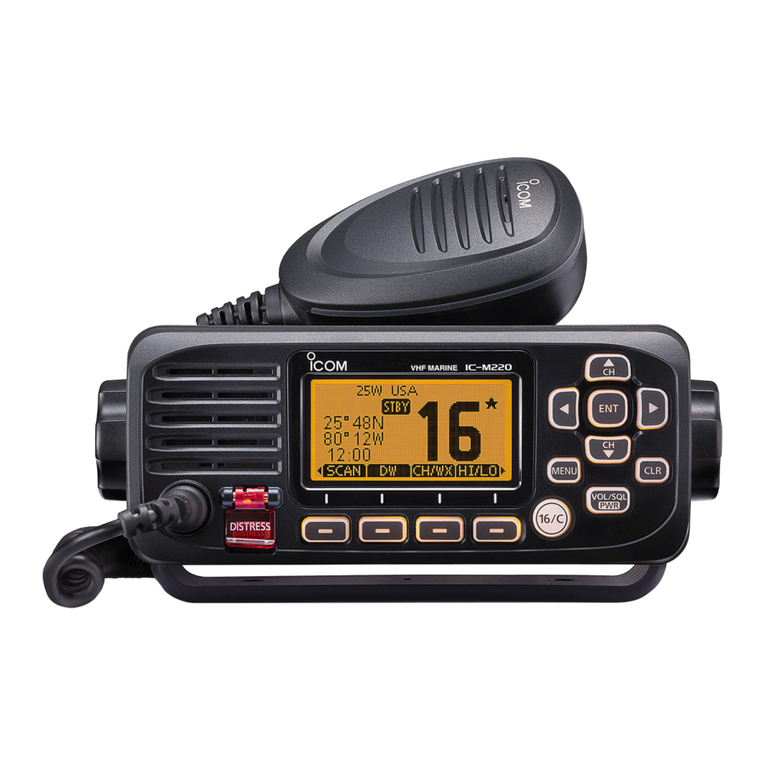
Icom
Icom IC-M220 User manual

Icom
Icom IC-F29SDR Installation guide
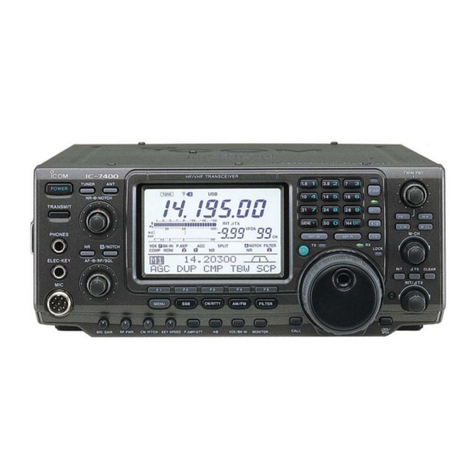
Icom
Icom IC-7400 User manual
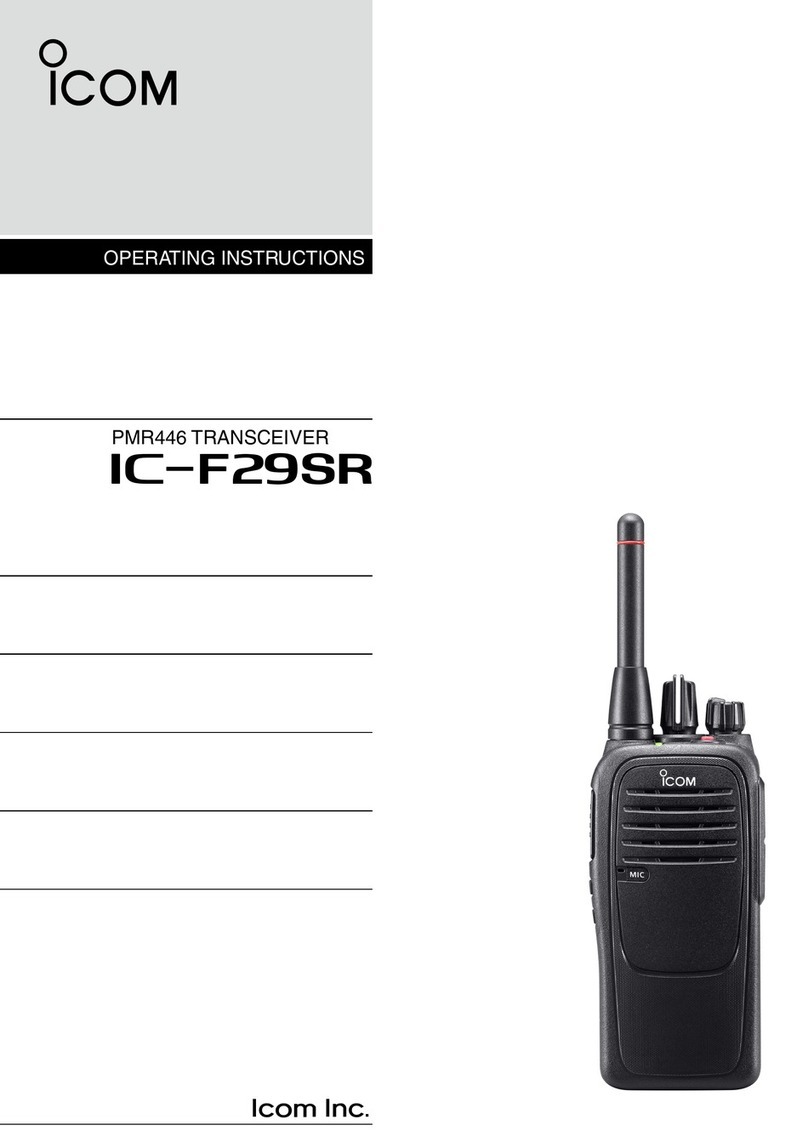
Icom
Icom IC-F29SR User manual
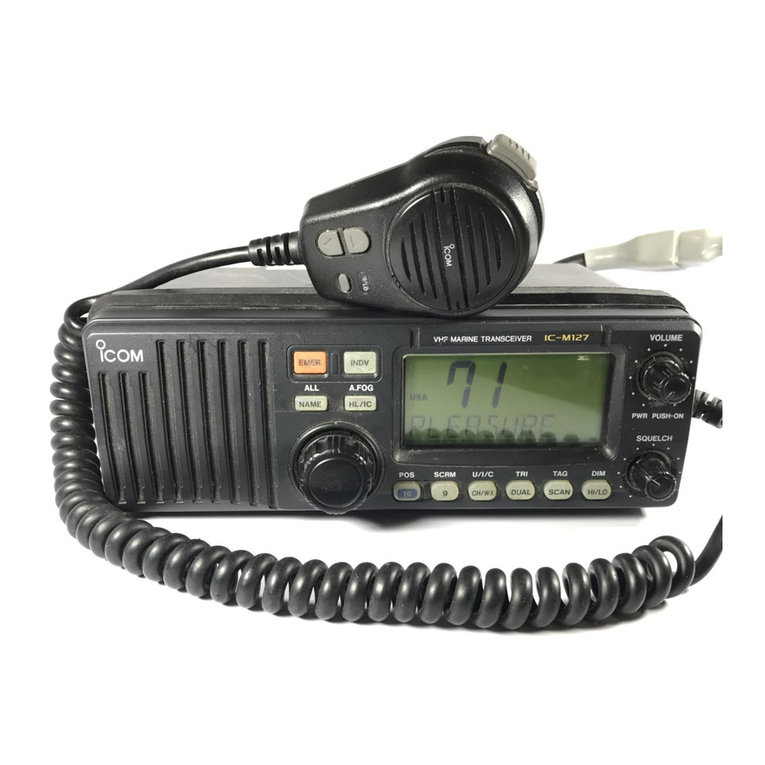
Icom
Icom IC-M127 User manual
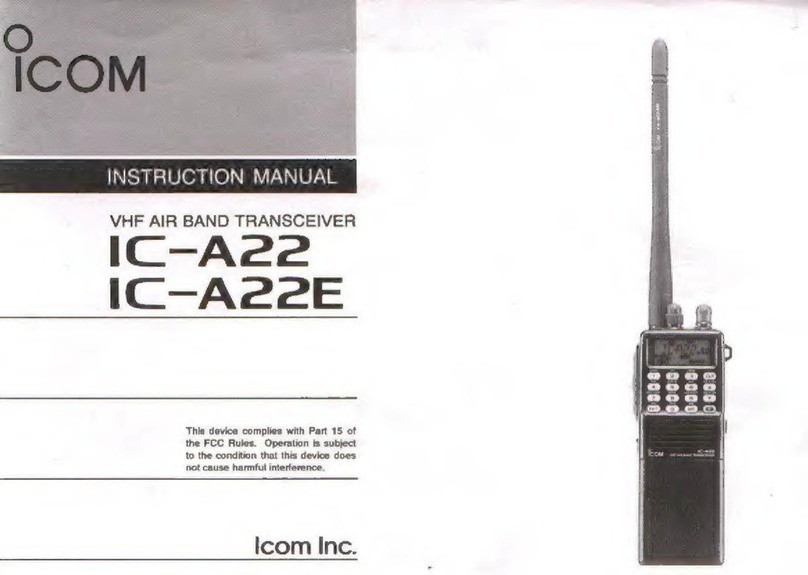
Icom
Icom IC-A22 User manual

Icom
Icom IC-F52D User manual
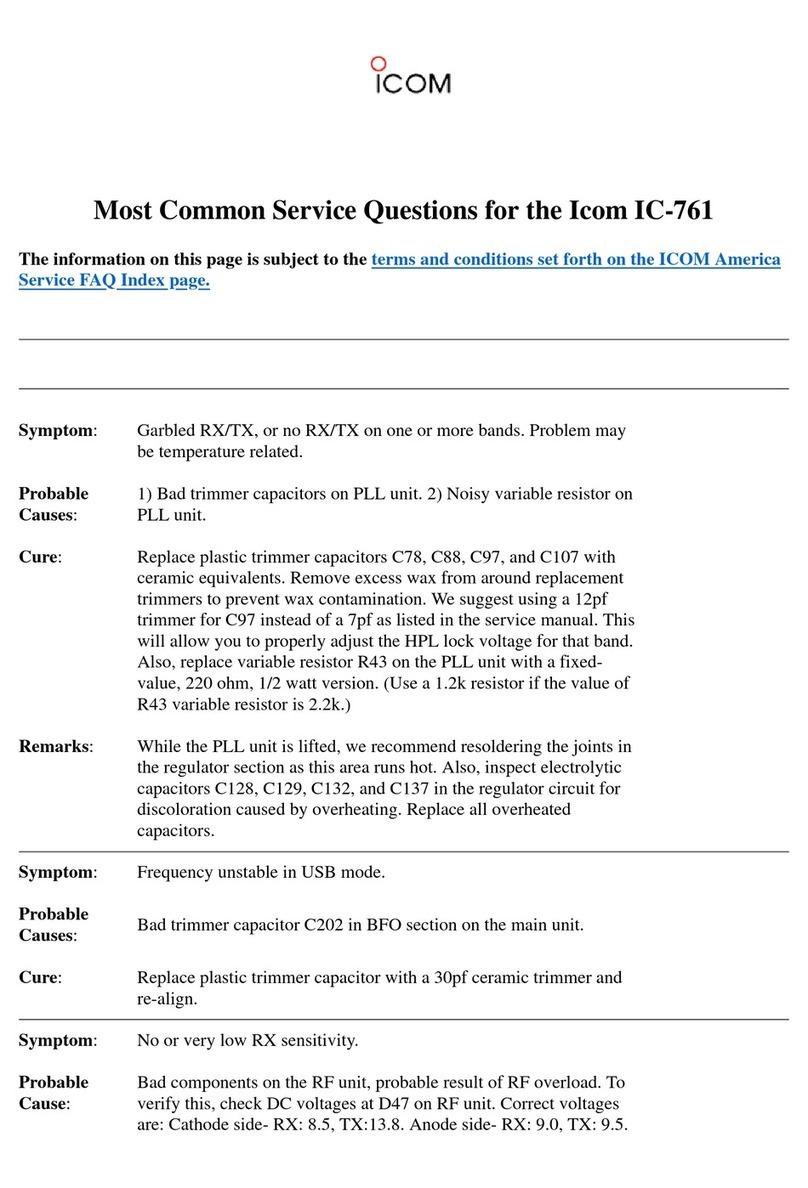
Icom
Icom IC-761 Instruction Manual

Icom
Icom IC-9100 Installation guide
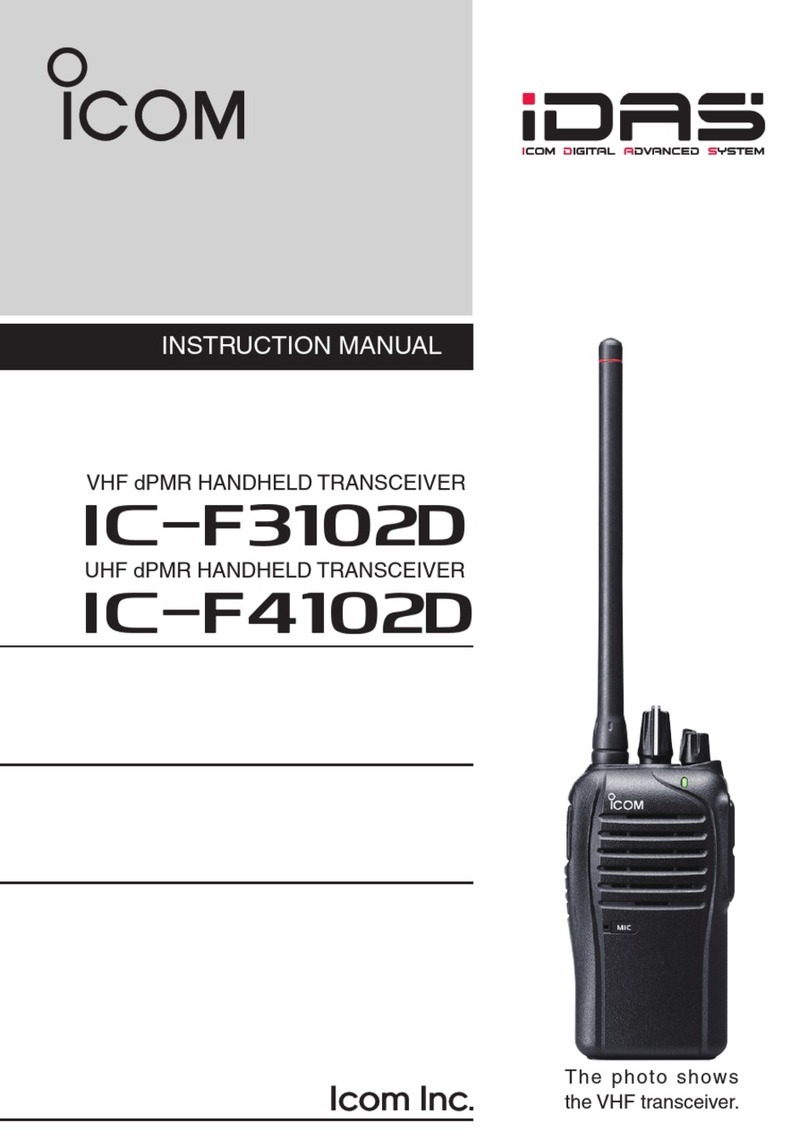
Icom
Icom iDAS IC-F3102D User manual
